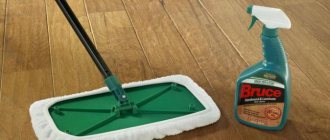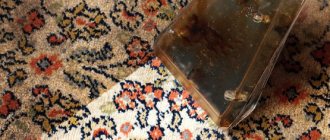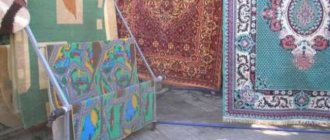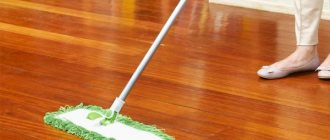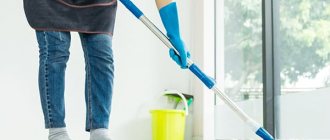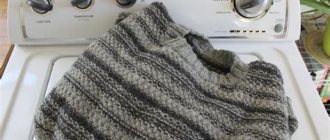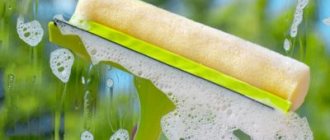The question of how to clean whitewash from the floor so that there are no streaks often arises after repairs have been carried out. But, since each floor covering has its own characteristics, it is necessary to know the correct cleaning technology. In this article we will take a detailed look at not only the various methods of cleaning limescale stains, but also tell you what additional compounds can be used.
Cleaning the remaining whitewash on the floor with a mop Source wuzunfans.com
Selecting inventory
Mop.
To find the right one, pay attention to:
- Material. Plastic and metal mops do not deteriorate when exposed to water and last longer than wooden ones. At the same time, metal is stronger and therefore can withstand higher loads than plastic.
- Functionality. If your apartment has little storage space, pay attention to folding models. The telescopic handle can be adjusted to suit your height to reduce the strain on your back. Another useful feature is a special lever for wringing out the rag.
- Dimensions. Mops with a long head help reduce the time it takes to clean a large area. But when choosing, you need to take into account that such models are not very maneuverable and do not wash the floor well in corners and hard-to-reach areas.
Rag.
Many housewives, out of habit, use cotton or flannelette rags. But modern aluminum and PVC mops are sold complete with a cleaning attachment. It can be sponge, rope or rag.
- Spongy. It quickly absorbs water, and to wring it out, you need to pull a special lever on the mop. The sponge nozzle collects hair well and is suitable for wooden and porcelain stoneware floors.
- Rope. The nozzle looks like a bundle of cotton or artificial fiber strands and is sold complete with a bucket with a special spin system. It is very maneuverable and collects dust and dirt well. Suitable for cleaning wooden floors and linoleum.
- Rag. The most popular is the microfiber nozzle. This material easily absorbs moisture, removes dirt and leaves no marks.
Bucket.
There are many buckets of different configurations on sale: regular, folding, with manual or mechanical spin. But the most convenient option, according to customer reviews, is a bucket with a squeeze: it has a special grill that removes excess moisture and dirt from the nozzle.
How to wash tiles and porcelain tiles: clean and streak-free
Every conscientious housewife sooner or later faces the pressing question: “How to wash ceramic tiles or porcelain stoneware so that the surface is perfectly clean and no white stains remain on it?” Fortunately, there are many ways you can clean your tiles to a shine without leaving unsightly marks on them. Let's look at those that have repeatedly proven and continue to prove their effectiveness to housewives.
Choosing a remedy
When choosing a detergent, consider the characteristics of the floor covering. Manufacturers of household chemicals offer special gels for parquet, laminate and linoleum. If you don’t have time to search for suitable chemicals, use folk recipes or order maintenance cleaning.
Folk
Vinegar.
Table vinegar (9%) is used for cleaning floors. Prepare a cleaning solution: mix 5 liters of water and 0.5–1 cup of vinegar, stir well. Vinegar removes soap stains well, gently disinfects and neutralizes allergens - pollen, dust mites.
Laundry soap.
Grate half the block and dissolve the shavings in warm water. Stir well so that there are no lumps of soap in the bucket. The solution copes with any contaminants, does not leave whitish streaks and does not cause allergies.
Spruce needles.
Needles are a natural antiseptic. It will help get rid of germs and unpleasant odors. Place several spruce branches in boiling water and boil for 5 minutes. Let the broth brew, then add the infusion to the water for washing the floor.
If you don’t want to prepare a spruce decoction, buy pine essential oil: the product retains natural antiseptic properties, so it destroys bacteria and unpleasant odors well. To wash the floor, add about 20 drops of essence to 5 liters of water. To enhance cleaning properties, you can mix the oil with 20 ml of vinegar (9%) and 5 ml of liquid detergent.
Soda.
For regular washing, regular baking soda is suitable, and for removing severe stains, soda ash is suitable. Add 2-5 tbsp to a bucket of water. l. soda and stir thoroughly. If necessary, you can increase the concentration of the solution.
Professional
Any professional floor cleaning product contains synthetic fragrances and surfactants - surfactants that dissolve dirt. There is a large selection of household chemicals for cleaning floors on the market. The most popular brands: Miene Liebe, Vaily, Sanfor, Glorix.
You should not use professional products more than once a week. Be sure to follow the dosage indicated in the instructions, especially if there are small children in the house: breathing chemicals is harmful, it can provoke an allergic reaction.
How to remove plaster, traces of whitewash
It is better to wipe off dried plaster stains as dry as possible. If there are tiles on the floor, just scrape it off with something, but try not to scratch it. For softer surfaces—linoleum—soak with acidified water (add vinegar) and scrub off little by little. If it is too difficult, any product with active acids will help to clean the floor. Among the most affordable are Toilet Duckling and similar products for the toilet or bathroom. But first read the composition - hydrochloric or any other acid should be indicated there. Just don’t try it on linoleum, parquet or laminate. Most likely, the coating will be damaged. If there is scrap material, test the product on it. After testing, is there any damage or discoloration? Try cleaning the plaster from the floor with this product.
How to wash linoleum after repair - with simple means: water + vinegar + dishwashing detergent
To clean the floor from putty or plaster, first try diluting a capful of the found acidic product in a small amount of water (a liter or one and a half). Apply the solution to the stain and wait a few minutes. Let's try to scrub it off. It helped - great. No, we're trying to increase concentration. Particularly persistent ones can be treated with an undiluted product. But if it doesn’t help, most likely you need to look for another remedy.
You can try softening plaster or putty stains with kerosene. Drop a couple of drops and wait, then try to wipe it off. But remember that it is better not to apply kerosene to laminate and linoleum.
When working with acids or kerosene, try to breathe “to the side.” Literally. The acid and kerosene evaporate and the vapor enters the lungs and can cause severe coughing. If you breathe long enough, it can even cause poisoning. In general, open the windows, ventilate and be careful. Whitewash, putty and other repair compounds are removed in the same way.
How to properly wash floors made of different materials
Before wet cleaning, be sure to sweep or vacuum the floor to remove small particles of dirt. The procedure is required if there are carpets in the house. To restore order and not spoil the floor covering, follow simple rules.
Parquet and wooden floors.
This is the most capricious coating: the wood must be washed with a damp cloth no more than once a week, otherwise the material may swell due to excess moisture. Do not use hot water for washing. You can remove dirty stains with ammonia. Be sure to rub the parquet with a special mastic to give the coating shine and protect it from damage.
Linoleum
afraid of detergents with abrasives: they scratch the coating. To wash the floor, you need to take a soft cloth and warm water with the addition of a special gel. To add shine, try this recipe: take milk and water in equal proportions, mix and wash the floor with this solution. When the linoleum is dry, polish it with a rag made from a single-stitched material (CPP) or a rag - a cloth made from recycled textiles.
Laminate
Do not expose it to strong moisture, otherwise it will swell. It is better to wash the floor no more than three times a week. The main problem with the coating is the whitish streaks that remain after washing. To get rid of them, use a special detergent, shampoo, liquid soap, washing gel or a solution of 9% vinegar.
Ceramic tile
- unpretentious material. It can be washed every day with regular laundry soap or washing powder diluted in warm water.
Self-leveling floors
. This is a very durable finish, but proper care is important to maintain its shine. The self-leveling floor can be washed with hot water and household chemicals. Do not use acids, caustic alkalis, or abrasives. After washing and complete drying, the self-leveling floor is waxed for shine.
Basics of proper cleaning
What care products are best to use and how to clean parquet without sanding. It should be noted that even a high-quality approach cannot save you if the correct parquet cleaning conditions are not met. Namely:
- To prevent the wooden floor from deforming, it is necessary to maintain the microclimate in the room.
- The air temperature should be from +18 to -25°C.
- Atmospheric humidity 40-55%.
- When the heating is on, humidification is required.
- During the rainy seasons - dry.
Wood is a material that quickly absorbs moisture. This can lead to the formation of mold and harmful bacteria.
It is not recommended to check the strength of parquet that has been freshly laid by a master. After the varnish composition has gained strength and 4-5 days have passed for the floor to shrink, you can begin operation. Please note that during installation, walking on parquet tiles is prohibited. It is not recommended to ventilate the room. This can cause surface “bubbling”. In the first 2 weeks you must follow some rules:
- walk carefully on the floor;
- neither run nor jump;
- when installing furniture, it is better to lay fiberboard;
- When cleaning parquet, do not apply it in water;
- the surface must not be covered with anything. Carpet materials are especially prohibited.
Otherwise, dark spots will appear after a few days.
For furniture legs it is necessary to use pads. They can be felt or rubberized. If there are wheels, they should be coated with silicone. Daily cleaning of parquet is recommended with dry material. If there is minor dirt, cleaning with a damp cloth is recommended. Dust - a vacuum cleaner with a special attachment or brush is recommended.
Maintenance measures for varnished surfaces
Lacquered flooring is preferable for rooms. It also makes parquet floors easier to clean. However, the coating should then be renewed.
Before you remove the top layer of the flooring yourself, you need to master the imitation of seams, as well as putty. From the beginning you should putty. To do this, you can buy a ready-made mixture in special stores. Or you can cook it yourself. Take sawdust and add varnish for coating. Next, you need to seal the seams yourself. You need to wait until the grout dries slightly. Run an awl along the joints along a ruler.
How to clean parquet without sanding? It is advisable to wash it weekly, no more. But only with the use of special cleaning products. Using components such as:
- Spray - apply to dirt, then wipe with a microfiber cloth.
- Specialist. compositions - soak a rag in them, wash, wring out, and dry.
How to clean tough stains
To remove difficult stains, use concentrated cleaning solutions or professional chemicals. The choice of product depends on the nature of the stain:
- An alkaline solution made from laundry soap or soda can deal with traces of oil.
- To get rid of glue stains, use oil-based compounds: most glues are fat-soluble, so the product will soften and dissolve the stain.
- Apply a piece of ice to the chewing gum stuck to the floor, and when it hardens, remove it. Remains of chewing gum are washed off with water with the addition of ammonia.
Plastic
Remnants of adhesive tape often need to be removed from the frame of a plastic window, PVC panels, the surface of household appliances and car parts.
To get rid of the problem carefully and not make it worse, the first thing you should do is familiarize yourself with the restrictions. To remove tape from plastic surfaces, you should not use:
- Abrasive cleaning products (powders, soda).
- Rough materials (melamine sponge, knife, spatula).
- Aggressive substances. This is especially true for glossy plastic: various chemical mixtures must be tested in an invisible place.
- Strong heating with an iron or hair dryer. Using a regular hair dryer is acceptable.
The easiest way to remove traces of tape from plastic is to use a soft cotton pad and vegetable oil. All you need to do is thoroughly wet the tampon with oil and rub until the problem disappears. Thanks to this technique, even old traces of glue are removed.
Regular dishwashing detergent or liquid soap will help remove fresh stains from the tape. Lather a soft sponge or cotton pad and rub away the sticky mark from the tape.
If the stain is old, and for some reason you can’t use oil, try a third, no less effective method: alcohol. You can try a glass and mirror cleaner or take undiluted ethyl (medicinal), methyl, or ammonia alcohol.
You should clean the contaminated area as you would with oil: wet a swab or napkin and rub. But you can use a simpler option: place a disc soaked in alcohol on the adhesive area and leave for 5 minutes. Afterwards, all that remains is to wipe the area with a clean cloth to remove any dirt.
Important! Be sure to check the effect of alcohol-containing solutions on an inconspicuous area of the surface being treated. You can clean small stains from adhesive tape without using liquids at all.
To do this, take a regular eraser for removing a simple pencil from paper (eraser, eraser, eraser) and rub until the glue from the tape completely rolls off. Afterwards, simply brush away the debris and wipe the surface with a clean rag.
You can clean small stains from adhesive tape without using liquids at all. To do this, take a regular eraser for removing a simple pencil from paper (eraser, eraser, eraser) and rub until the glue from the tape completely rolls off. Afterwards, simply brush away the debris and wipe the surface with a clean rag.
In the most serious cases, instead of improvised means, use special professional tape removers, which can be found in construction, hardware or auto stores:
- Anti-Scotch. An aerosol that makes it easy to remove stickers from plastic, glass, and painted substrates. Apply from a distance of 15-20 cm from contamination, does not flow even from vertical surfaces. Most often used for cleaning machine parts, because... does not cause corrosion and does not damage the coating. It acts 2-3 minutes after application, allowing you to simply remove the sticker or tape from the base without leaving a trace.
- Sticker remover from Brauberg (Brauberg Max). Available in spray form, suitable for any hard surface, but prolonged contact with plastic is not recommended. Apply, leave for 20-30 seconds, remove along with the stain using a plastic spatula or cloth.
How to wash a floor after renovation
The stains remaining after the repair will have to be washed off in several stages:
- Remove large construction debris.
- Use a damp broom to remove the bulk of the dirt.
- Wash the floor with detergent and water.
If traces remain after washing, repeat the procedure.
Construction dust
A saline solution will help remove construction dust. First, wash the floor with detergent, and then add 0.5 cups of salt to a bucket of clean water, treat the floor and wipe the floor with clean water. Salt can be replaced with a couple of drops of potassium permanganate.
Dye
Drops of paint from the floor should be removed immediately, otherwise it will dry out and it will be more difficult to remove it without harming the floor covering. The most effective way is to study the composition of the paint and select the appropriate solvent. For example, water-dispersion or water-based paint can be washed off with plain water, and oil or alkyd paint can be washed off with white spirit or turpentine. If you can’t buy a suitable solvent, then try to clean dried traces of paint with a spatula or soften them with vegetable oil.
Whitewash
To wash whitewash, use a saline solution. Another effective way: mix 1 liter of water and 1 tsp. sunflower oil and rinse dirty areas thoroughly with the mixture. Then treat the coating with a weak solution of vinegar: to prepare the solution, mix 2-3 tbsp. l. 9% vinegar and 5 liters of warm water. The procedure will help clean the coating from dirt and restore its shine.
Important nuances
Methods for cleaning the floor primarily depend on the material of manufacture. But there are a number of general rules that must be followed when washing any coating:
- Before you start putting things in order, you need to remove everything unnecessary from the surface (carpet, scattered toys or favorite slippers).
- Bulky interior parts that cannot be removed from the room can simply be moved aside to wipe the surface underneath them.
- First, the room needs to be swept or vacuumed. This will help remove major debris and make the washing process more efficient.
- Wiping the surface should begin from the far corner of the room, gradually moving closer to the door.
- Skirting boards must be cleaned with special care.
How to properly wash the floor in a house with children
If there are small children in the house, then you should be more careful in cleaning the house from dust and dirt. Traditional methods are safe for health, so you can safely wash the floor with soap or vinegar solution.
Household chemicals are better at neutralizing bacteria, viruses and fungi, but they can cause allergies, so it is important to follow the recommended dosages. It is better to choose products without fragrances and preservatives and to ventilate the room well while cleaning. Do not use cleaning products more than once a week.
A small praise to “Domestos”
After repairs, you have to remove contaminants of various origins, and it is convenient to use universal products. There are quite a few of them on the market; we will mention Domestos Pine Fresh. It is highly rated by many users; the product removes whitewash well, along with other stains.
Instructions:
- The liquid is diluted in water, maintaining a ratio of 2 tbsp. l. funds for 5 l.
- Use the prepared solution to wipe all surfaces with stains and streaks.
- Remains of the product are removed with a cloth soaked in clean water.
“Mr. Muscle”, “Mr. Proper” or specialized household chemicals will also help to wash off the limescale.
Renovation is an update, but also a lot of work. To prevent the new walls and snow-white ceiling from spoiling the mood with stains on the floor, doors and windows, you need to start cleaning right away. There are quite a few ways to quickly get rid of traces of whitewash - choose the one that suits you best and enjoy an updated, refreshed environment and cleanliness.
If there are pets in the house
If a dog or cat marks the territory, then regular washing will not get rid of the smell. Special tools will help here:
- Potassium permanganate. Dissolve 5-6 drops in a glass of water, soak a sponge in the solution and wipe the stain. Then wash the floor with cold, clean water and wipe dry.
- White. The product contains toxic chlorine, so it is better to dilute bleach with water in proportions of 1:10. Use the resulting solution to wipe the contaminated area of the floor and wash with clean water. Wear gloves when working.
- Washing powder. Dilute a couple of tablespoons of the product and thoroughly wash the entire floor in the room. To consolidate the result, dilute a glass of 95% medical alcohol in a bucket of water and wipe the floor again.
Video description
How to clean linoleum from construction dust.
Linoleum
This floor covering is not afraid of moisture, so it can be easily processed using a washing vacuum cleaner or mop. For cleaning, you can use household solid or liquid soap, special floor cleaners, vinegar, table salt, sodium permanganate.
These products are considered absolutely harmless. Just before cleaning, they must be properly mixed with water, otherwise even more stains will occur. It should be noted that gasoline, peroxide, and any types of alcohol and solvents are prohibited. They are capable of eating away the pattern on the linoleum covering.
Also, for this type of coating, various compositions of household chemicals are often used. Just before using them, it is recommended to study whether the selected composition is suitable for finishing, and how to properly dilute it before use.
The most important
- Pay attention to the choice of equipment: a properly selected mop and rag will help you quickly and effectively clean the house.
- Remember that different floor coverings have their own characteristics: this is important to consider when choosing the right cleaner.
- Dose detergents correctly. Too much concentration of the active substance can damage the floor covering, leave stains or cause allergies. Weak solutions will not cope with the removal of strong contaminants.
- Do not allow excess water. Laminate, parquet, unpainted wooden boards, and cork deteriorate from exposure to moisture. The rag must be carefully wrung out so that it is slightly damp and not wet.
Basic recommendations
There are rules that are known to experienced people. The floors in the house need to be washed efficiently and quickly. These tips will also help you clean the room after renovation.
Even before the cleaning process begins, you should move all the objects that are on the floor. Roll up the carpet so it won’t create any interference, and place the stools to the side. First clean the floor with a vacuum cleaner or simply sweep the room
It is important to inspect the space under the bed, sofa, and look under the closet. The dust that accumulates there may force you to start cleaning all over again if you don't clean these areas first.
Cleaning should begin at the furthest point from the door.
First you need to wash the area around the baseboards and walls, then move on to the central part of the room, and then to the exit. To get rid of stains, you should thoroughly wipe the floor with a slightly damp cloth or dry it with a mop; the floor should be washed several times.
We use laundry soap
Laundry soap is a universal stain remover. The second wash is carried out with this product. It will not remove white stains, but it will significantly reduce dirt. Fresh whitewash in a small amount will be completely removed by laundry soap. It is also indispensable for removing lime and chalk from doors and window frames.
Soapy water is prepared as follows:
- A small part of the bar is ground on a grater.
- The shavings are placed in a container with warm water.
- Shake until dissolved.
The product is used to wash the floor, doors, windows, and if the finishing allows, then the walls. To increase efficiency, add a little vinegar.
Advice: If you wet the surfaces with a concentrated soap solution before working with whitewash, it will be much easier to remove lime.

